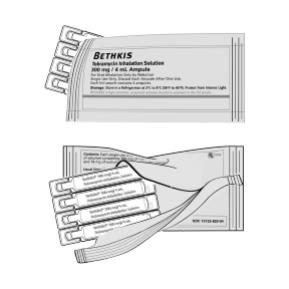BETHKIS
These highlights do not include all the information needed to use BETHKIS safely and effectively. See full prescribing information for BETHKIS. BETHKIS® (tobramycin inhalation solution), for oral inhalation use Initial U.S. Approval: 1980
1cd3d47b-025f-4705-9daf-cf07725ec223
HUMAN PRESCRIPTION DRUG LABEL
Feb 24, 2023
Chiesi USA, Inc.
DUNS: 088084228
Products 1
Detailed information about drug products covered under this FDA approval, including NDC codes, dosage forms, ingredients, and administration routes.
tobramycin
Product Details
FDA regulatory identification and product classification information
FDA Identifiers
Product Classification
Product Specifications
INGREDIENTS (5)
Drug Labeling Information
PACKAGE LABEL.PRINCIPAL DISPLAY PANEL
PACKAGE/LABEL PRINCIPAL DISPLAY PANEL - ampule label

Bethkis® 300 mg/ 4 mL
Tobramycin Inhalation Solution
WARNINGS AND PRECAUTIONS SECTION
5 WARNINGS AND PRECAUTIONS
5.1 Ototoxicity
Ototoxicity with use of BETHKIS
Caution should be exercised when prescribing BETHKIS to patients with known or suspected auditory or vestibular dysfunction.
Findings related to ototoxicity as measured by audiometric evaluations and auditory adverse event reports were similar between BETHKIS and placebo in controlled clinical trials. Hearing loss was reported in two (1.1%) BETHKIS- treated patients and in one (0.9%) placebo-treated patient during clinical studies. Additionally, dizziness and vertigo, both of which may be manifestations of vestibular forms of ototoxicity, were observed in similar numbers of BETHKIS- and placebo-treated patients. Dizziness occurred in two (1.1%) BETHKIS-treated patients and one (0.9%) placebo-treated patient and vertigo occurred in two (1.1%) BETHKIS-treated patients versus no placebo patients in clinical studies. None of the BETHKIS patients discontinued their therapy due to hearing loss, dizziness or vertigo.
Tinnitus may be a sentinel symptom of ototoxicity. No reports of tinnitus occurred in patients during clinical studies with BETHKIS, but because it has been observed with inhaled tobramycin solutions [see Adverse Reactions (6.2)], onset of this symptom warrants caution. Ototoxicity, manifested as both auditory and vestibular toxicity, has been reported with parenteral aminoglycosides. Vestibular toxicity may be manifested by vertigo, ataxia or dizziness. Patients with known or suspected auditory or vestibular dysfunction should be closely monitored when taking BETHKIS. Monitoring may include obtaining audiometric evaluations and serum tobramycin levels. If ototoxicity is noted, the patient should be managed as medically appropriate, including potentially discontinuing BETHKIS.
Risk of Ototoxicity Due to Mitochondrial DNA Variants
Cases of ototoxicity with aminoglycosides have been observed in patients with certain variants in the mitochondrially encoded 12S rRNA gene (MT-RNR1), particularly the m.1555A>G variant. Ototoxicity occurred in some patients even when their aminoglycoside serum levels were within the recommended range. Mitochondrial DNA variants are present in less than 1% of the general US population, and the proportion of the variant carriers who may develop ototoxicity as well as the severity of ototoxicity is unknown. In case of known maternal history of ototoxicity due to aminoglycoside use or a known mitochondrial DNA variant in the patient, consider alternative treatments other than aminoglycosides unless the increased risk of permanent hearing loss is outweighed by the severity of infection and lack of safe and effective alternative therapies.
5.2 Nephrotoxicity
Caution should be exercised when prescribing BETHKIS to patients with known or suspected renal dysfunction.
Nephrotoxicity was not seen during BETHKIS clinical studies but has been associated with aminoglycosides as a class. Patients with known or suspected renal dysfunction or taking concomitant nephrotoxic drugs along with BETHKIS should have serum concentrations of tobramycin and laboratory measurements of renal function obtained at the discretion of the treating physician. If nephrotoxicity develops, the patient should be managed as medically appropriate, including potentially discontinuing BETHKIS until serum concentrations fall below 2 mcg/mL.
Twenty-six (14%) BETHKIS patients and 15 (13%) placebo patients had increases in serum creatinine of at least 50% over baseline. Follow-up values were obtained for 17 of the 26 BETHKIS patients, all of which decreased to serum creatinine values that were within normal laboratory ranges. Patients who experience an increase in serum creatinine during treatment with BETHKIS should have their renal function closely monitored.
5.3 Neuromuscular Disorders
BETHKIS should be used cautiously in patients with muscular disorders.
Aminoglycosides, including tobramycin, may aggravate muscle weakness because of a potential curare-like effect on neuromuscular function. Neuromuscular blockade, respiratory failure, and prolonged respiratory paralysis may occur more commonly in patients with underlying neuromuscular disorders, such as myasthenia gravis or Parkinson’s disease. Prolonged respiratory paralysis may also occur in patients receiving concomitant neuromuscular blocking agents. If neuromuscular blockade occurs, it may be reversed by the administration of calcium salts but mechanical assistance may be necessary.
5.4 Bronchospasm
Bronchospasm has been reported with inhalation of tobramycin. In clinical studies with BETHKIS, bronchospasm was observed in one (0.5%) BETHKIS-treated patient and in no placebo-treated patients. Wheezing occurred in ten (5%) BETHKIS-treated patients and four (4%) placebo-treated patients. Bronchospasm and wheezing should be treated as medically appropriate.
5.5 Laboratory Tests
Audiograms
Clinical studies of inhaled tobramycin solutions did not identify hearing loss using audiometric tests which evaluated hearing up to 8000 Hz. Physicians should consider an audiogram for patients who show any evidence of auditory dysfunction, or who are at increased risk for auditory dysfunction. Tinnitus may be a sentinel symptom of ototoxicity, and therefore the onset of this symptom warrants caution.
Serum Concentrations
In patients with normal renal function treated with BETHKIS, serum tobramycin concentrations range from approximately 0.06-1.89 mcg/mL one hour after dose administration and do not require routine monitoring. Serum concentrations of tobramycin in patients with renal dysfunction or patients treated with concomitant parenteral tobramycin should be monitored at the discretion of the treating physician [see Clinical Pharmacology (12.3)].
The serum concentration of tobramycin should only be monitored through venipuncture and not finger prick blood sampling. Contamination of the skin of the fingers with tobramycin may lead to falsely increased measurements of serum levels of the drug. This contamination cannot be completely avoided by hand washing before testing.
Renal Function
The clinical studies of BETHKIS did not reveal any imbalance in the percentage of patients who experienced at least a 50% rise in serum creatinine from baseline in either the BETHKIS group (n=26, 14%) or the placebo group (n=15, 13%). Laboratory tests of urine and renal function should be conducted at the discretion of the treating physician.
5.6 Embryo-Fetal Toxicity
Aminoglycosides can cause fetal harm when administered to a pregnant woman. Aminoglycosides cross the placenta, and streptomycin has been associated with several reports of total, irreversible, bilateral congenital deafness in pediatric patients exposed in utero. However, systemic absorption of tobramycin following inhaled administration is expected to be minimal [see Clinical Pharmacology (12.3)]. Patients who use BETHKIS during pregnancy, or become pregnant while taking BETHKIS should be apprised of the potential hazard to the fetus [see Use in Specific Populations (8.1)].
5.7 Concomitant Use of Systemic Aminoglycosides
Patients receiving concomitant BETHKIS and parenteral aminoglycoside therapy should be monitored as clinically appropriate for toxicities associated with aminoglycosides as a class. Serum tobramycin levels should be monitored.
-
Caution should be exercised when prescribing BETHKIS to patients with known or suspected auditory, vestibular, renal, or neuromuscular dysfunction. (5.1, 5.2, 5.3 and 5.5)
-
Aminoglycoside may aggravate muscle weakness because of a potential curare-like effect on neuromuscular function. (5.3)
-
Bronchospasm can occur with inhalation of BETHKIS. (5.4)
-
Audiograms, serum concentration, and renal function should be monitored as appropriate. (5.2 and 5.5)
-
Fetal harm can occur when aminoglycosides are administered to a pregnant woman. Apprise women of the potential hazard to the fetus. (5.6)
DRUG INTERACTIONS SECTION
7 DRUG INTERACTIONS
7.1 Drugs with Neurotoxic, Nephrotoxic, or Ototoxic Potential
Concurrent and/or sequential use of BETHKIS with other drugs with neurotoxic, nephrotoxic, or ototoxic potential should be avoided.
7.2 Diuretics
Some diuretics can enhance aminoglycoside toxicity by altering antibiotic concentrations in serum and tissue. Therefore, BETHKIS should not be administered concomitantly with ethacrynic acid, furosemide, urea, or intravenous mannitol. The interaction between inhaled mannitol and BETHKIS has not been evaluated.
-
Concurrent and/or sequential use of BETHKIS with other drugs with neurotoxic, nephrotoxic or ototoxic potential should be avoided. (7.1)
-
BETHKIS should not be administered concomitantly with ethacrynic acid, furosemide, urea, or intravenous mannitol. (7.2)
USE IN SPECIFIC POPULATIONS SECTION
8 USE IN SPECIFIC POPULATIONS
8.1 Pregnancy
Risk Summary
Aminoglycosides can cause fetal harm. Published literature reports that use of streptomycin, an aminoglycoside, can cause total, irreversible, bilateral congenital deafness when administered to a pregnant woman [Warnings and Precautions (5.6)]. Although there are no available data on use of BETHKIS in pregnant women to be able to inform a drug-associated risk of major birth defects, miscarriage, or adverse maternal or fetal outcomes, systemic absorption of tobramycin following inhaled administration is expected to be minimal [see Clinical Pharmacology (12.3)]. There are risks to the mother associated with cystic fibrosis in pregnancy (see Clinical Considerations). In animal reproduction studies with subcutaneous administration of tobramycin in pregnant rats and rabbits during organogenesis there were no adverse developmental outcomes; however, ototoxicity was not evaluated in the offspring from these studies (see Data). Advise pregnant women of the potential risk to a fetus.
The estimated background risk of major birth defects and miscarriage for the indicated populations are unknown. All pregnancies have a background risk of birth defect, loss, or other adverse outcomes. In the U.S. general population, the estimated background risk of major birth defects and miscarriage in clinically recognized pregnancies is 2 to 4% and 15 to 20%, respectively.
Clinical Considerations
Disease-Associated Maternal and/or Embryo/Fetal Risk
Cystic fibrosis may increase the risk for preterm delivery.
Data
Animal Data
No reproduction toxicology studies have been conducted with inhaled tobramycin. However, subcutaneous administration of tobramycin at doses of up to 100 (rat) or 20 (rabbit) mg/kg/day during organogenesis was not associated with adverse developmental outcomes. Subcutaneous doses of tobramycin ≥ 40mg/kg/day were severely maternally toxic to rabbits and precluded the evaluation of adverse developmental outcomes. Ototoxicity was not evaluated in offspring during nonclinical reproductive toxicity studies with tobramycin.
8.2 Lactation
Risk Summary
There are no data on the presence of tobramycin in either human or animal milk, the effects on the breastfed infant, or the effects on milk production following oral inhalation of BETHKIS. Limited published data on other formulations of tobramycin in lactating women indicate that tobramycin is present in human milk. However, systemic absorption of tobramycin following inhaled administration is expected to be minimal [see Clinical Pharmacology (12.3)]. Tobramycin may cause alteration in the intestinal flora of the breastfeeding infant (see Clinical Considerations). The developmental and health benefits of breastfeeding should be considered along with the mother’s clinical need for BETHKIS and any potential adverse effects on the breastfed child from BETHKIS or from the underlying maternal condition.
Clinical Considerations
Tobramycin may cause intestinal flora alteration. Advise a woman to monitor the breastfed infant for loose or bloody stools and candidiasis (thrush, diaper rash).
8.4 Pediatric Use
The safety and efficacy of BETHKIS have not been studied in pediatric cystic fibrosis patients under six years of age.
8.5 Geriatric Use
Clinical studies of BETHKIS did not include patients aged 65 years and over. Tobramycin is known to be substantially excreted by the kidney, and the risk of adverse reactions to this drug may be greater in patients with impaired renal function. Because elderly patients are more likely to have decreased renal function, it may be useful to monitor renal function [see Warnings and Precautions (5.2, 5.5)].
8.6 Renal Impairment
Tobramycin is primarily excreted unchanged in the urine and renal function is expected to affect the exposure of tobramycin. The risk of adverse reactions to this drug may be greater in patients with impaired renal function. Patients with serum creatinine > 2mg/dL and blood urea nitrogen (BUN) > 40mg/dL have not been included in clinical studies and there are no data in this population to support a recommendation for or against dose adjustment [see Warnings and Precautions (5.2, 5.5)].
Serum concentrations of tobramycin in patients with renal dysfunction, or patients treated with concomitant parenteral tobramycin should be monitored at the discretion of the treating physician.
-
Aminoglycosides can cause fetal harm when administered to a pregnant woman. (8.1)
-
Nursing mothers: discontinue drug or nursing, taking into consideration the importance of the drug to a mother. (8.2)
DOSAGE & ADMINISTRATION SECTION
2 DOSAGE AND ADMINISTRATION
2.1 Dosage
Bethkis is for oral inhalation only [see Dosage and Administration (2.2)]. The recommended dosage of BETHKIS for patients six years of age and older is to administer one single-use ampule (300 mg/4 mL) twice daily by oral inhalation in repeated cycles of 28 days on drug, followed by 28 days off drug. The doses should be taken as close to 12 hours apart as possible and not less than 6 hours apart.
The 300 mg/4 mL dose of BETHKIS is the same for patients regardless of age or weight. BETHKIS has not been studied in patients less than six years old.
If patients miss a dose, they should take it as soon as possible anytime up to 6 hours prior to their next scheduled dose. If less than 6 hours remain before the next dose, wait until their next scheduled dose.
2.2 Administration Instructions
BETHKIS is administered by oral inhalation using a hand-held PARI LC PLUS Reusable Nebulizer with a PARI Vios Air compressor over an approximately 15 minute period and until sputtering from the output of the nebulizer has occurred for at least one minute. BETHKIS should not be diluted or mixed with dornase alfa or other medications in the nebulizer. BETHKIS is not for subcutaneous, intravenous, or intrathecal administration.
Further patient instructions on how to administer BETHKIS are provided in the Patient’s Instructions for Use [see Patient Counseling Information (17)].
BETHKIS should not be used if it is cloudy, if there are particles in the solution, or if it has been stored at room temperature for more than 28 days.
-
For oral inhalation only (2.1)
-
Administer the entire contents of one ampule twice daily by oral inhalation in repeated cycles of 28 days on drug, followed by 28 days off drug. (2.1)
DESCRIPTION SECTION
11 DESCRIPTION
BETHKIS is a sterile, clear, colorless to pale yellow, non-pyrogenic, aqueous solution with pH and salinity adjusted. BETHKIS is administered by a compressed air driven reusable nebulizer. The chemical formula for tobramycin is C18H37N5O9 and the molecular weight is 467.52. Tobramycin is O-3-amino-3-deoxy-α-D-glucopyranosyl-(1→4)-O-[2,6-diamino- 2,3,6-trideoxy-α-D- ribo-hexopyranosyl-(1→6)]-2-deoxy-L‑streptamine.
The structural formula for tobramycin is:
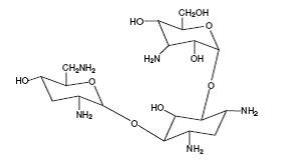
Each single-use 4 mL ampule of BETHKIS contains one 300 mg dose of tobramycin, with sodium chloride and sulfuric acid in water for injection. Sulfuric acid and sodium hydroxide are used, as needed, to adjust the pH to 5.0. Nitrogen is used for sparging, filling and pouching. The formulation contains no preservatives.
NONCLINICAL TOXICOLOGY SECTION
13 NONCLINICAL TOXICOLOGY
13.1 Carcinogenesis, Mutagenesis, Impairment of Fertility
A two-year rat inhalation toxicology study to assess carcinogenic potential of an inhaled solution of tobramycin has been completed. Rats were exposed to tobramycin for up to 1.5 hours per day for 95 weeks. Serum levels of tobramycin up to 35 mcg/mL were measured in rats, 35x the average 1 mcg/mL exposure levels observed in cystic fibrosis patients in clinical trials. There was no drug-related increase in the incidence of any variety of tumors.
Additionally, tobramycin has been evaluated for genotoxicity in a battery of in vitro and in vivo tests. The Ames bacterial reversion test, conducted with five tester strains, failed to show a significant increase in revertants with or without metabolic activation in all strains. Tobramycin was negative in the mouse lymphoma forward mutation assay, did not induce chromosomal aberrations in Chinese hamster ovary cells, and was negative in the mouse micronucleus test.
Subcutaneous administration of up to 100 mg/kg of tobramycin did not affect mating behavior or cause impairment of fertility in male or female rats.
HOW SUPPLIED SECTION
16 HOW SUPPLIED/STORAGE AND HANDLING
16.1 How Supplied
BETHKIS 300 mg/4 mL is supplied as a sterile, clear, colorless to pale yellow, non-pyrogenic, aqueous solution and is available as follows:
-
NDC 10122-820-56: 4 mL single-use ampule (carton of 14 foil pouches each containing four ampules)
-
NDC 10122-820-28: 4 mL single-use ampule (carton of 7 foil pouches each containing four ampules)
16.2 Storage and Handling
BETHKIS should be stored under refrigeration at 2°C ‑ 8°C (36°F ‑ 46°F). Upon removal from the refrigerator, or if refrigeration is unavailable, BETHKIS pouches (opened or unopened) may be stored at room temperature [up to 25°C (77°F)] for up to 28 days. BETHKIS should not be used beyond the expiration date stamped on the ampule when stored under refrigeration 2°C ‑ 8°C (36°F ‑ 46°F) or beyond 28 days when stored at room temperature [up to 25°C (77°F)].
BETHKIS ampules should not be exposed to intense light. BETHKIS is light sensitive; unopened ampules should be returned to the foil pouch. The solution in the ampule is colorless to pale yellow, but may darken with age if not stored in the refrigerator; however, the color change does not indicate any change in the quality of the product as long as it is stored within the recommended storage conditions.
INSTRUCTIONS FOR USE SECTION
Instructions for Use
BETHKIS**®**
(BETH kiss)
(tobramycin inhalation solution)
Follow the instructions below for taking BETHKIS. If you have any questions, ask your healthcare provider or pharmacist.
BETHKIS is available as a 28-day supply containing 56 ampules including 14 foil pouches and as a 14-day supply containing 28 ampules including 7 foil pouches. Each foil pouch contains 4 BETHKIS ampules.
Supplies you will need to take BETHKIS (See Figure A):
-
1 ampule of BETHKIS
-
PARI LC PLUS reusable nebulizer
-
PARI Vios compressor
-
tubing to connect the nebulizer and compressor
-
clean paper or cloth towels
-
nose clips (optional)
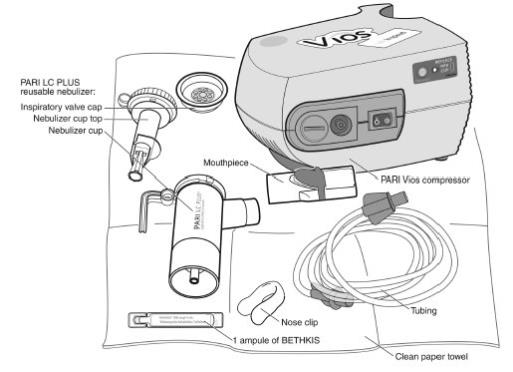
(Figure A)
BETHKIS is used only in a PARI LC PLUS re-usable Nebulizer connected to a PARI LC PLUS Vios air compressor. Make sure you know how to use your nebulizer machine before you use it to breathe in BETHKIS.
Do not mix BETHKIS with other medicines in your nebulizer.
BETHKIS comes in a sealed foil pouch. Do not open a sealed pouch until you are ready to use a dose of BETHKIS. After opening the pouch, unused ready-to-use ampules should be returned to, and stored in, the pouch.
Getting ready:
-
Put your PARI LC PLUS Reusable Nebulizer Top and Bottom (Nebulizer Cup) Assembly, Inspiratory Valve Cap, Mouthpiece with Valve, and Tubing on a clean and dry surface.
-
Wash your hands with soap and water.
Preparing your BETHKIS dose:
Step 1: Open foil pouch. (See Figure B)
|
|
(Figure B)
Step 2: Separate 1 ampule by gently pulling apart at the bottom tabs (See Figure C) and use it right away.
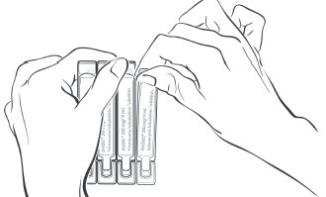
(Figure C)
Step 3: Hold the bottom tab on the BETHKIS ampule with 1 hand (See Figure D). With your other hand, hold the top of the ampule and twist off the top of the ampule (See Figure D).
- Do not squeeze the ampule until you are ready to squeeze all the medicine into the Nebulizer Cup.
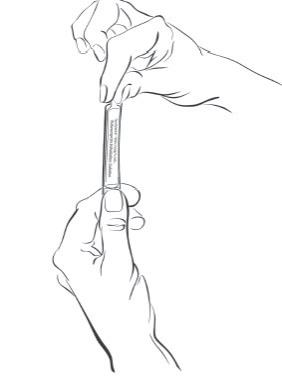
(Figure D)
Step 4: Hold the Nebulizer Cup and twist off the Nebulizer Cup Top in a counter-clockwise direction (See Figure E). Set the Top aside on a clean, dry surface.
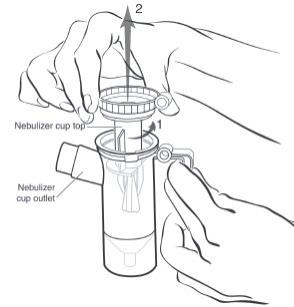
(Figure E)
Step 5: Squeeze all of the medicine from the ampule into the Nebulizer Cup (See Figure F).
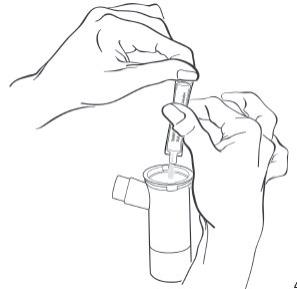
(Figure F)
Step 6: Line up the semi-circle on the Nebulizer Cup Top with the Nebulizer Cup Outlet and twist on the Nebulizer Cup Top in a clock-wise direction until it is tight. (See Figure G).
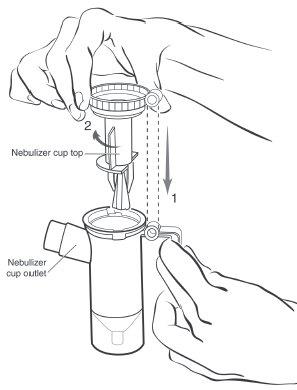
(Figure G)
Step 7: Push the mouthpiece straight onto the Nebulizer Cup Outlet (See Figure H).
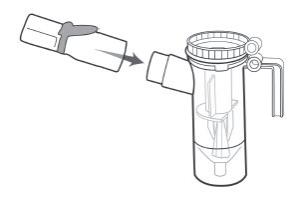
(Figure H)
Step 8: Firmly push the Inspiratory Valve Cap straight down onto the Nebulizer Cup Top (See Figure I). The Inspiratory Valve Cap should fit tightly.
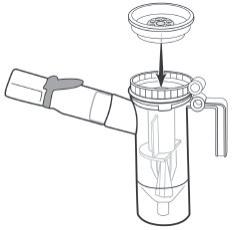
(Figure I)
**Step 9:**Connect 1 end of the tubing to the compressor air outlet. The tubing should fit tightly (See Figure J).
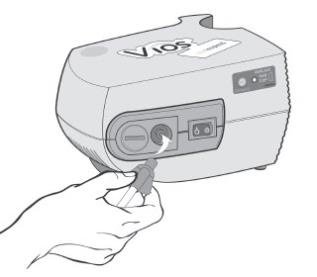
(Figure J)
Step 10: Plug your compressor plug into an electrical outlet (See Figure K).

(Figure K)
Step 11: Hold the Nebulizer Cup upright and firmly push the free end of the tubing straight up onto the Air Intake on the bottom of the Nebulizer Cup (See Figure L).Make sure to keep the Nebulizer Cup upright.
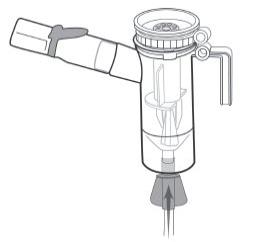
(Figure L)
Giving your BETHKIS dose:
Step 12: Turn on the compressor (Figure M) and check the Mouthpiece. You should see a steady mist coming from the Mouthpiece (Figure N).
- If you do not see a steady mist coming from the mouthpiece, check all tubing connections and make sure that the compressor is working the right way.
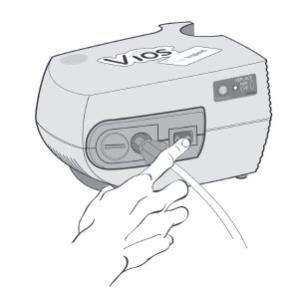
(Figure M)
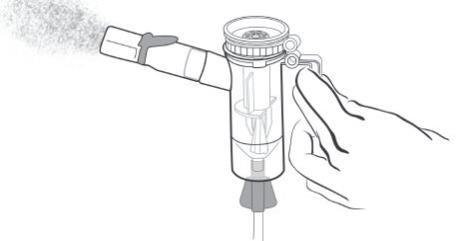
(Figure N)
Step 13: Sit or stand in a comfortable, upright position that will let you breathe normally. Place the Mouthpiece between your teeth and on top of your tongue and breathe normally only through your mouth (See Figure O).
- Nose clips may help you breathe only through your mouth and not through your nose.
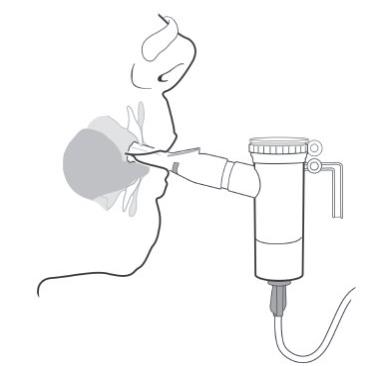
(Figure O)
Step 14: Keep breathing in your BETHKIS dose for at least 15 minutes. You will know that you have received your full dose of medicine when you hear a “spitting noise” coming from the Mouthpiece for at least 1 minute and the Nebulizer Cup is empty.
After your BETHKIS Dose:
Step 15: Clean and disinfect your nebulizer (see manufacturer’s instructions).
Care and Use of Your PARI Vios**®**Compressor
Follow the manufacturer’s instructions for care and use of your compressor.
How should I store BETHKIS?
-
Store BETHKIS in the refrigerator at 36°F to 46°F (2°C to 8°C) until needed.
-
After removing from the refrigerator, or if refrigeration is not available, BETHKIS foil pouches (opened or unopened) may be stored at room temperatureup to 77 °F (25 °C) for up to 28 days.
-
If BETHKIS is not stored in the refrigerator but at room temperature up to 77 °F (25 °C) it may turn dark. If BETHKIS turns dark, it does not change how well BETHKIS works. BETHKIS can still be used as long as it is stored at room temperatureup to 77 °F (25 °C).
-
Do not use BETHKIS after the expiration date printed on the ampule.
-
Keep BETHKIS ampules in the foil pouch and away from light.
-
Return unopened ampules to the foil pouch
*Keep BETHKIS and all medicines out of the reach of children.
This Patient Information and Instructions for Use have been approved by the U.S. Food and Drug Administration
Manufactured for Chiesi USA, Inc.
by Woodstock Sterile Solutions, Inc.
Woodstock, Illinois 60098
All trademarks referenced herein are the property of their prospective owners.
Issued: 2/2023
CTB-006-1022-06-SPL

